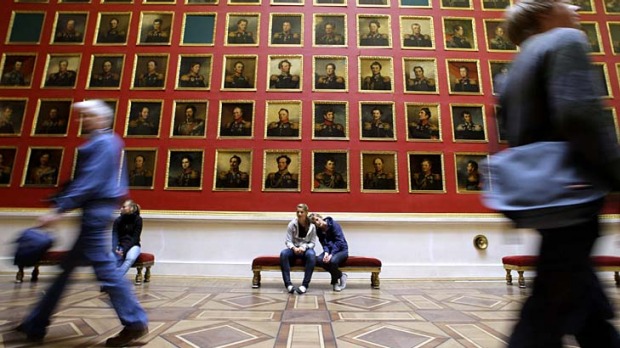
So much art. So much backache. Lissa Christopher tours the behemoth State Hermitage Museum in St Petersburg.
If there were to be a collective noun for the contents of the world's largest galleries and museums, it ought to be a backache. Just as you refer to a parliament of owls, so you'd refer to a backache of artworks and artefacts, or perhaps simply a backache of masterpieces.
I say this having recently spent two days at St Petersburg's adjective-defying State Hermitage Museum. It contains literally millions of treasures, from Rembrandt, Matisse and van Dyck paintings to Syrian glassware, Siberian skeletons and Graeco-Etruscan vases. And, as if its contents weren't astounding enough, the building's interiors - elaborate parquetry, rococo doorknobs, extreme gilt - are as lush as those of the palace at Versailles. It's hard to know where to look.
No complaints there. The catch is that in order to appreciate it all, you have to adopt the museum stroll - that cursed stop-start amble that clocks up marathon distances by stealth - for hours on end. The result: awe, delight, terrible backache.
The breadth of the Hermitage collection is testament to Catherine the Great's acquisitiveness and commitment to the arts. She started it in the 1760s and acquired tens of thousands of objects in her lifetime. The collection has since grown to more than 3 million objects. Not all of them are on display - it just feels that way.
I start my two-day ordeal/odyssey with the western European paintings on the top floor, with a naive plan to work my way down systematically (three floors, three buildings). Robert Lefevre's 1805 portrait of Yelizaveta Demidova greets me at the top of the stairs. She has a book in her hand, her feet on a cushion and a look on her face that says, "you're a fool".
Finding Monet's The Lady in the Garden is like running into an old acquaintance. I think she visited Canberra once. Fancy seeing you here. But, of course, this is where you live. You and Matisse's Dance, Leonardo da Vinci's Madonna Litta, Rubens' Bacchus, Gainsborough's Lady in Blue ... You and so many other masterpieces. The Hermitage houses the largest collection of paintings in the world.
And then there's all the other stuff.
Beyond the paintings, my favourite is the collection of 2500-year-old artefacts exhumed from the Siberian permafrost. It includes thick women's tights, the knees pouchy with wear; children's clothes made from animal hide, the fur still intact; exquisitely carved gold buckles; and a sheet of tattooed skin from a man's arm.
The tights fascinate me most. Body-worn and intimate, they're almost familiar, yet the woman who wore them has been dead for millenniums and lived in Siberia - to me, a sort of byword for isolated and freezing beyond human endurance. Staring into the glass case and trying to imagine her life sends chills up my (aching) spine.
In two days I also see Russian palace furnishings, Japanese miniatures, English porcelain, ancient Greek statuary, Roman jewellery, Chinese silks, Turkish rugs, prehistoric tools and more. None of it is dull.
The place is busy but not uncomfortably so, except when I cross paths with a tour group - those noisy, sheep-like camera-wielders - but they're easy enough to overtake.
Intermittently, I get lost. The Hermitage comprises several interconnected buildings with rooms and corridors slightly offset and clustered together in maze-like loops, each with multiple exits. Sometimes you have to go up and come back down again, through an Escher-like arrangement of stairs, just to keep going in a straight line.
I'm reluctant to ask directions from the unsmiling museum attendants. And when I say unsmiling, I mean they look like they want to spit on you, possibly even stab you through the heart. I kind of enjoy it. It feels very ... Russian.
On the first day I want to leave, preferably in an ambulance, about two hours before I actually do and not just because I can't find the exit. While searching for it, I inevitably catch a glimpse of some intriguing, previously unseen object or room and think, "just one more". One more masterpiece, one more room, one more hour, one more kilometre.
Close to a flight of stairs that finally leads to an exit, I pass a skeleton in a glass box with no information on it. It could be another long-dead Siberian. It could be a tourist who perished tragically close to freedom.
But seriously, I loved every minute of my visit to the Hermitage, despite the fatigue, and imagine few would feel otherwise. I definitely recommend spending more than one day here. Two days is barely adequate. A week of half-day visits might do the trick - but only just.
FAST FACTS
Getting there
Emirates has a fare to St Petersburg from Sydney and Melbourne for about $1930 low-season return including tax. Fly to Dubai (about 14hr), then to St Petersburg (6hr 35min); see emirates.com. This fare allows you to travel via Bangkok, Singapore or KL and back from another European city. Australians need a visa for a stay of up to 30 days, requiring a visa invitation letter from a government-registered travel agency.
Viewing there
Buy entrance vouchers online and print them before you leave home to save queuing. The vouchers are exchanged for tickets at the museum. A two-day combined ticket, costing $US25.95 ($25), to be used on consecutive days, is recommended. A single-entry ticket costs $US17.95. The English-language tours give an overview of the collection and layout. The pithy audio tours are also excellent. See hermitagemuseum.org.